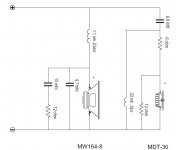I recently built some 12L sealed bookshelves using Morel MW-164 woofers. I am now interested in putting them into a ported enclosure of about 30L just for kicks. I want to see how this affects the low frequency response. I am also interested if by porting, the speaker will loose its nice tight mid-bass punch.
My question is regarding the crossover. I had Madisound design the crossover for me with LEAP according to the 12L sealed enclosure. What would be required to modify the crossover if I were to put it into the ported enclosure? Would the inductors remain the same and only tweak the capacitors and the resistors? Is this a complete crossover redesign?
Any help, thoughts, or suggestions are appreciated.
Jeff
My question is regarding the crossover. I had Madisound design the crossover for me with LEAP according to the 12L sealed enclosure. What would be required to modify the crossover if I were to put it into the ported enclosure? Would the inductors remain the same and only tweak the capacitors and the resistors? Is this a complete crossover redesign?
Any help, thoughts, or suggestions are appreciated.
Jeff
Should work fine without any crossover mods since porting a box only affects frequencies below, say, 100Hz to 200Hz.
The only exceptions are if any baffle correction has been applied or if the resonant hump has been notched out. Baffle correction is only usually done in TMM boxes and you can tell if a notch filter has been applied if there's a series R-L-C circuit directly across the XO input.
Nice one,
David.
The only exceptions are if any baffle correction has been applied or if the resonant hump has been notched out. Baffle correction is only usually done in TMM boxes and you can tell if a notch filter has been applied if there's a series R-L-C circuit directly across the XO input.
Nice one,
David.
By the resonant hump notched out, I assume you mean impedance correction. If so, then this has been implemented into the design with the inductor being incorporated into the filters inductor (make sense????).
By the resonant hump, I mean the large peak in impedance at the box/driver's resonant frequency and NOT the rise in impedance caused by the voice coil inductance. To correct for the former you use an R-L-C notch filter directly across the woofer or the XO input whereas correcting the latter requires a R-C Zobel network across the woofer only. The only kits I've seen which use a notch filter are from Dynaudio.
The reason that this will affect your transition from a sealed box to a ported is that sealed only has one hump at resonance whereas a ported box has two humps, one either side of the tuning frequency.
Nice one,
David.
The reason that this will affect your transition from a sealed box to a ported is that sealed only has one hump at resonance whereas a ported box has two humps, one either side of the tuning frequency.
Nice one,
David.
The 10mfd cap and 12R resistor across the woofer cancel the imdedance rise caused by voice coil inductance.
You should be fine with this crossover in a ported box.
Nice one,
David.
You should be fine with this crossover in a ported box.
Nice one,
David.
I think the LPad should be before the crossover network of the tweeter.
And yes, this crossover is fine for ported box 🙂
And yes, this crossover is fine for ported box 🙂
What is the benefit of putting the L-pad in front of the crossover?
Will this effect the values of the capacitor and inductor?
Will this effect the values of the capacitor and inductor?
IMHO the L-pad should be nearest the driver, so the rest of the crossover sees an even, level impedance.
Depending on your drivers, you may need to adjust the rest of the crossover, as L-pads will attenuate the HF, and cause some response variations.
Depending on your drivers, you may need to adjust the rest of the crossover, as L-pads will attenuate the HF, and cause some response variations.
Is their a good article anywhere on the net that describes how to tweak a crossover.
Example, if I were to adjust the value of the tweeters inductor, what would happen?
Example, if I were to adjust the value of the tweeters inductor, what would happen?
pinkmouse said:IMHO the L-pad should be nearest the driver, so the rest of the crossover sees an even, level impedance.
Depending on your drivers, you may need to adjust the rest of the crossover, as L-pads will attenuate the HF, and cause some response variations.
Sorry to come back on old things but I was tweaking my crossover for my Totem Arro clone and after many measurements, I still think the LPad should be before the crossover network because it is better to feed the network with the right level of the signal. Also, since the crossover network attenuate the signal, the LPad will be smaller and easier to adjust independently of the crossover. So if you change the LPad value, you won't change the impedance seen by the network so you will not have to change the component value of the crossover each time you change the LPad attenuation. If the crossover needs an even level of impedance, you have to add an impedance compensation network (usually added to remove the hash of the tweater). I checked in a few books and I did not find any information on where to put the LPad. So my LPad will be first!
🙂
- Status
- Not open for further replies.
- Home
- Loudspeakers
- Multi-Way
- Box effect on crossover???
